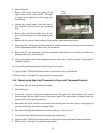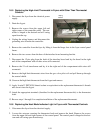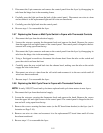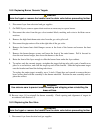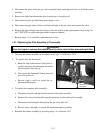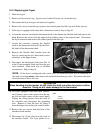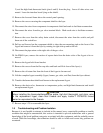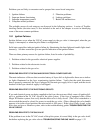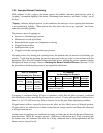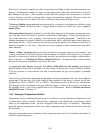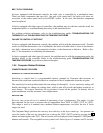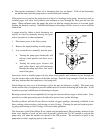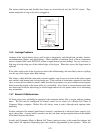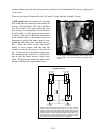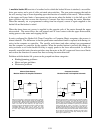
1-17
1.9.2 Improper Burner Functioning
With problems in this category, the burner ignites but exhibits abnormal characteristics such as
“popping,” incomplete lighting of the burner, fluctuating flame intensity, and flames “rolling” out of
the fryer.
“Popping” indicates delayed ignition. In this condition, the main gas valve is opening but the burner
is not immediately lighting. When ignition does take place, the excess gas “explodes” into flame,
rather than smoothly igniting.
The primary causes of popping are:
• Incorrect or fluctuating gas pressure
• Misdirected or weak pilot flame
• Burner deflector targets out of alignment or missing
• Clogged burner orifices
• Inadequate make-up air
• Clogged vent tube, causing incorrect gas pressure
If popping occurs only during peak operating hours, the problem may be incorrect or fluctuating gas
pressure. Verify that the incoming gas pressure (pressure to the gas valve) is in accordance with the
appropriate CE or Non-CE Standard found in the table below, and that the pressure remains constant
throughout all hours of usage. Refer to Checking the Burner Manifold Pressure (Section 1.3) for
the procedure to checking the pressure of gas supplied to the burner.
Non-CE Standard
for Incoming Gas Pressures
Gas Minimum Maximum
Natural
6" W.C.
1.49 kPa
14.93 mbar
14" W.C.
3.48 kPa
34.84 mbar
LP
11" W.C.
2.74 kPa
27.37 mbar
14" W.C.
3.48 kPa
34.84 mbar
CE Standard
for Incoming Gas Pressures
G20 20 18 x 1,40 mm 7,5 mbar
3,00 m
3
/h
G25 20 - 25 18 x 1,40 mm 10 mbar
3,50 m
3
/h
G31 37 - 50 18 x 0,86 mm 20,6 mbar
2,21 kg/h
(1) mbar = 10,2 mm H
2
O
Gas
Pressure
(mbar)
(1)
Regulator
Pressure ConsumptionOrifice Diameter
If popping is consistent during all hours of operation, verify that the pilot is properly positioned
above the burner orifice and that the pilot pressure is correct. Correct pilot pressure is indicated by a
flame 1 to 1½” (25 to38 mm) long. Refer to Section 1.6 for the pilot flame adjustment procedure.
Clogged burner orifices, especially those near the pilot, are also likely causes of delayed ignition.
Clogged orifices are indicated by no flame, flames that are orange-colored, and flames that shoot out
at an angle from the rest.
Another cause of popping is an insufficient air supply or drafts that are blowing the pilot flame away
from the burner. Check for “negative pressure” conditions in the kitchen area. If air is flowing into
the kitchen area, this indicates that more air is being exhausted than is being replenished and the
burners may be starved for air.



